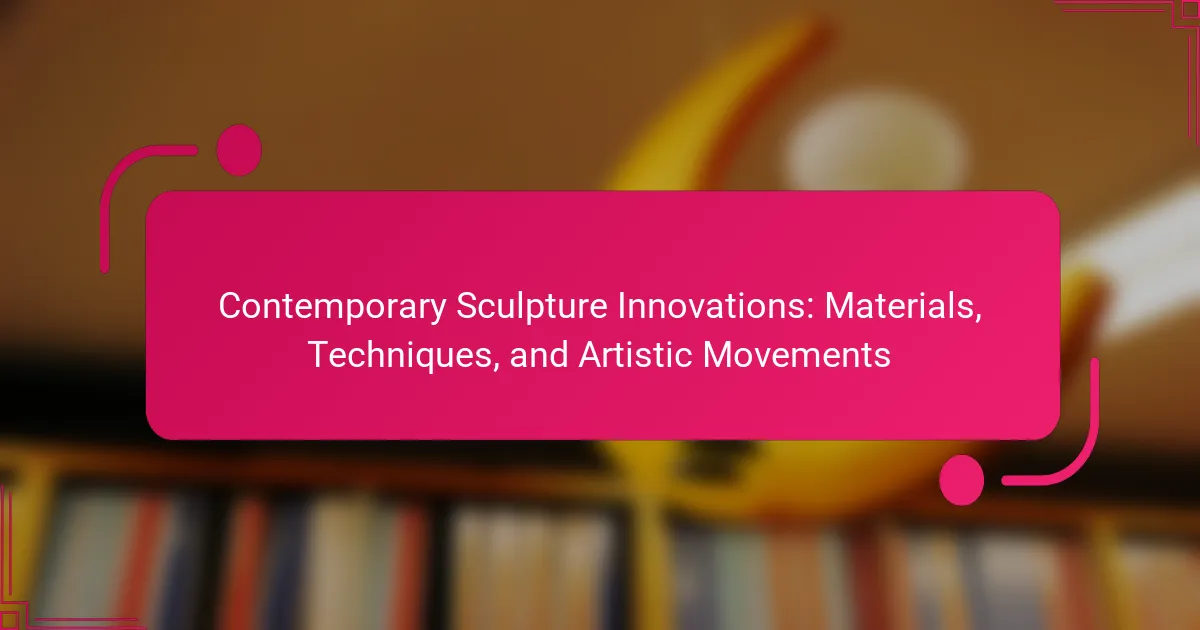Contemporary sculpture innovations address sustainability and audience engagement through new materials and techniques. Artists are utilising 3D-printed plastics, recycled metals, and organic materials. Techniques now incorporate technology, enhancing interactivity and merging physical and digital realms. Influential artistic movements emphasise minimalism, conceptual art, and environmental themes, reflecting diverse cultural narratives and evolving audience expectations.
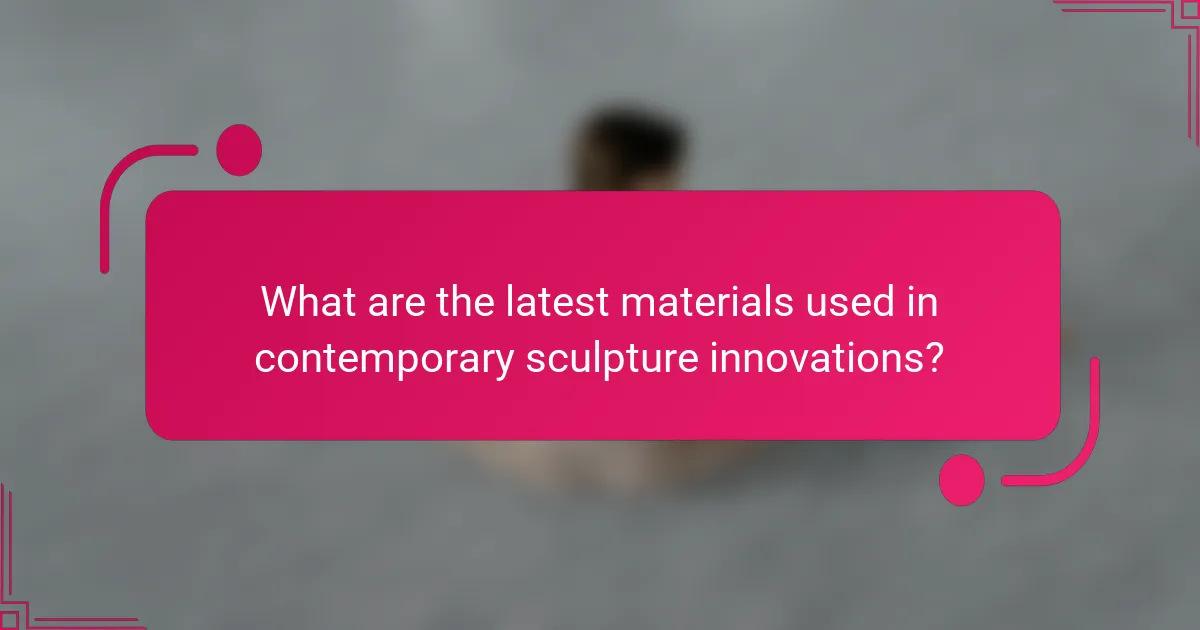
What are the latest materials used in contemporary sculpture innovations?
Contemporary sculpture innovations increasingly utilise materials like 3D-printed plastics, recycled metals, and organic materials. These choices enhance sustainability and push artistic boundaries. For example, artists experiment with bio-materials like mycelium and plant-based resins, reflecting environmental consciousness. Additionally, the use of augmented reality in sculptures allows for interactive experiences, merging physical and digital realms.
How do sustainable materials influence artistic expression?
Sustainable materials significantly enhance artistic expression by enabling innovative techniques and fostering environmental awareness. Artists increasingly use recycled, biodegradable, and locally sourced materials, which not only reduce ecological footprints but also inspire new forms and concepts in contemporary sculpture. For example, the use of reclaimed wood or plastic waste can transform traditional practices, encouraging audiences to engage with environmental issues through art. This shift towards sustainability reflects a unique attribute of contemporary artistic movements, where the choice of materials becomes a statement about social responsibility and ecological consciousness.
Which unconventional materials are gaining popularity among sculptors?
Sculptors are increasingly using unconventional materials like recycled plastics, found objects, and bio-based composites. These materials offer sustainability and unique aesthetic qualities. For instance, recycled plastics allow for large-scale installations while minimising waste. Found objects provide a narrative element, connecting art to everyday life. Bio-based composites, derived from natural sources, blend innovation with environmental consciousness.
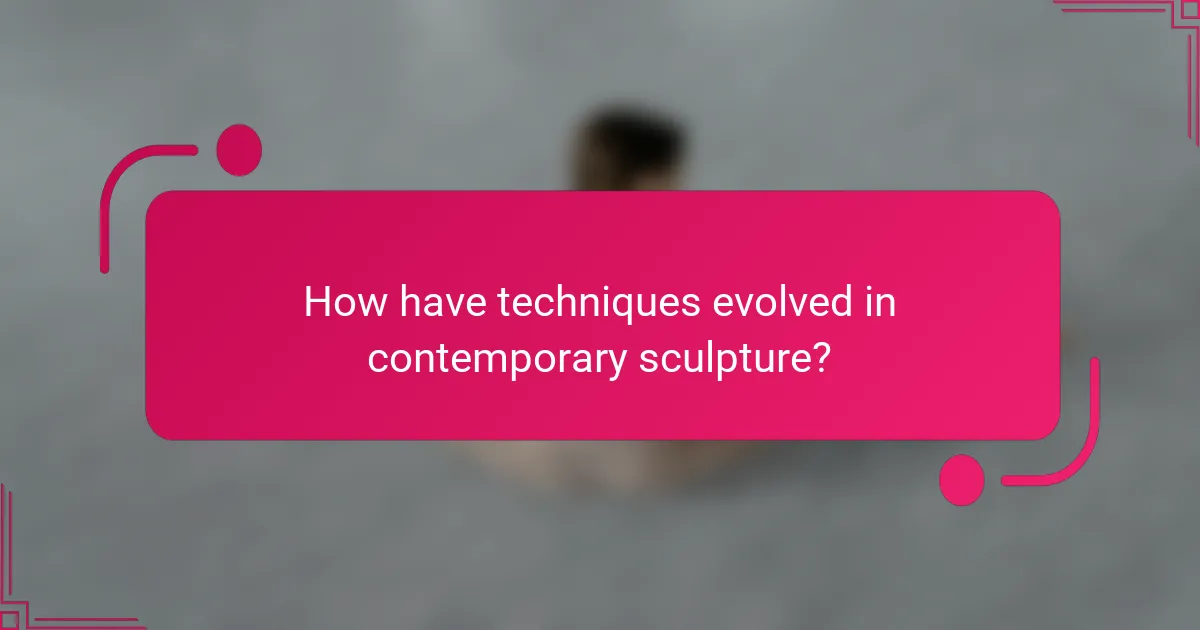
How have techniques evolved in contemporary sculpture?
Contemporary sculpture has evolved significantly through innovative materials, techniques, and artistic movements. Artists now utilise diverse materials such as recycled objects, digital media, and interactive installations. Techniques have shifted towards incorporating technology, including 3D printing and augmented reality, which allow for new forms of expression. Movements like installation art and environmental sculpture reflect contemporary issues, engaging viewers in immersive experiences. This evolution demonstrates a blend of traditional craftsmanship with modern technology, expanding the boundaries of sculpture.
What role does technology play in modern sculpting methods?
Technology significantly enhances modern sculpting methods by introducing innovative materials and advanced techniques. Digital tools like 3D modelling software allow artists to visualise and refine their concepts before physical creation. Techniques such as CNC machining and 3D printing enable precise fabrication, allowing for complex designs that traditional methods cannot achieve. Additionally, augmented reality and virtual reality tools provide immersive experiences that redefine artistic engagement. These technological advancements contribute to the evolution of contemporary sculpture, expanding creative possibilities and facilitating new artistic movements.
How do traditional techniques integrate with contemporary practices?
Traditional techniques integrate with contemporary practices by blending time-honoured craftsmanship with modern materials and concepts. Artists often utilise traditional sculpting methods while incorporating innovative technologies such as 3D printing. This fusion enhances creative expression and expands the boundaries of sculpture. For instance, traditional clay modelling may be combined with digital design, allowing for intricate details and new forms. Moreover, contemporary movements often emphasise sustainability, prompting artists to use recycled materials alongside classic techniques. This synergy fosters a dynamic dialogue between past and present, enriching the art form.
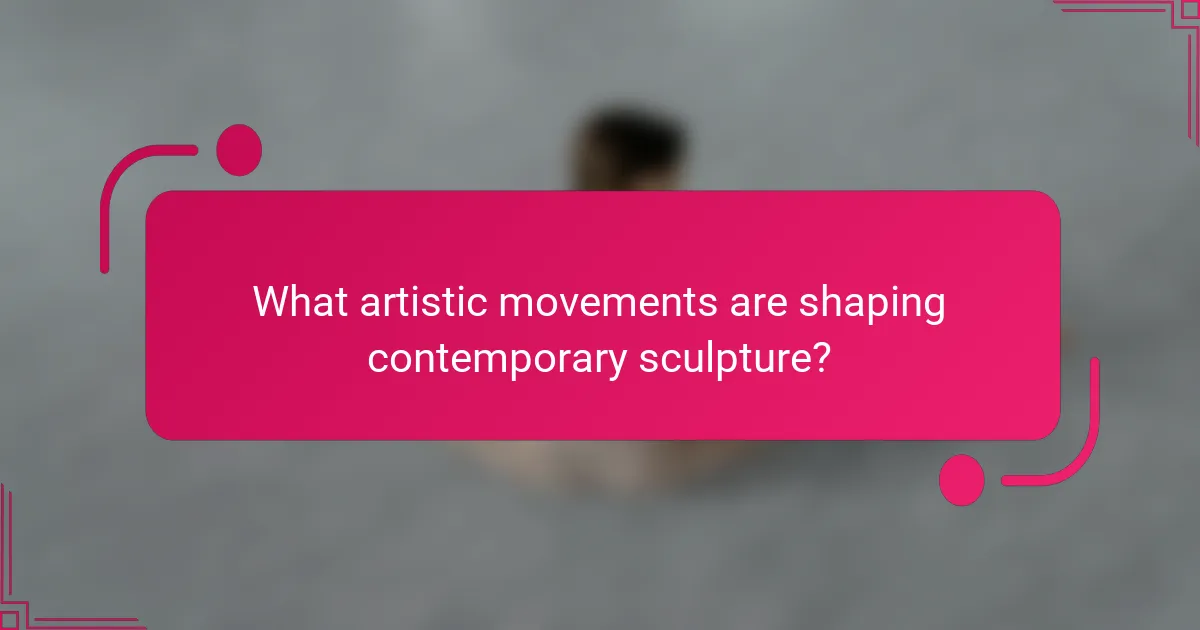
What artistic movements are shaping contemporary sculpture?
Contemporary sculpture is influenced by movements like minimalism, conceptual art, and environmental art. These movements emphasise innovative materials, sustainability, and the integration of technology. Minimalism focuses on simplicity and form, while conceptual art prioritises ideas over aesthetics. Environmental art engages with ecological themes, often utilising natural materials. This evolution reflects a shift toward interdisciplinary approaches and audience interaction in contemporary sculpture.
Which movements are most influential in the 2025 art scene?
The 2025 art scene is significantly influenced by eco-sculpture, digital fabrication, and community engagement. Eco-sculpture emphasises sustainability, using recycled materials and promoting environmental awareness. Digital fabrication techniques, such as 3D printing, enable artists to create complex forms and explore new aesthetics. Community engagement movements prioritise collaboration, inviting public participation in the artistic process and fostering social connections. These trends reflect a shift towards inclusivity, innovation, and environmental consciousness in contemporary sculpture.
How do cultural contexts affect contemporary sculptural practices?
Cultural contexts significantly shape contemporary sculptural practices through influences on materials, techniques, and artistic movements. Artists often draw inspiration from cultural heritage, social issues, and local environments, impacting their creative choices.
For example, the use of indigenous materials reflects a connection to cultural identity. Techniques may also vary, as artists incorporate traditional methods alongside modern technologies. Artistic movements, such as environmental art, often emerge from cultural responses to global challenges, showcasing the interplay between culture and contemporary sculpture.
Moreover, unique attributes of specific cultures can lead to rare sculptural forms, enriching the global art landscape. This diversity fosters innovation, allowing for a broader dialogue within the art community.
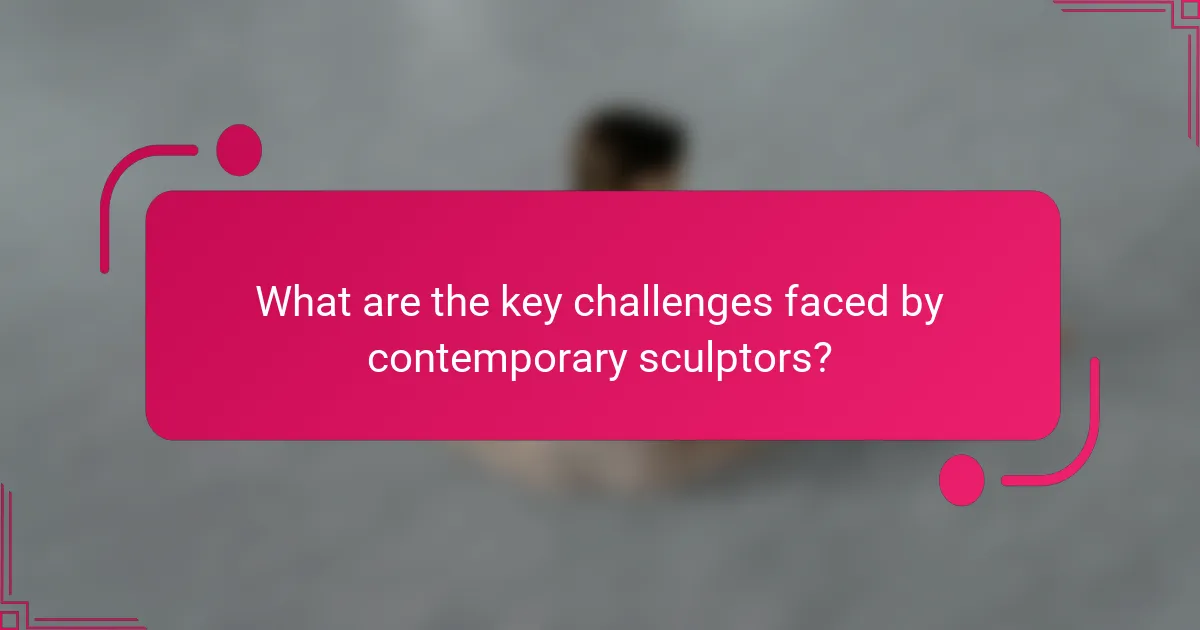
What are the key challenges faced by contemporary sculptors?
Contemporary sculptors face challenges such as material limitations, evolving technology, and shifting audience expectations. These factors impact both the creation and reception of their work.
Material innovations require sculptors to adapt to new mediums, which can be costly and technically demanding. Additionally, advancements in technology, such as 3D printing, change traditional sculpting methods, necessitating skill development.
Audience expectations have evolved, with a growing demand for interactive and immersive experiences. This shift pressures artists to innovate continuously while maintaining their unique artistic voice.
Lastly, environmental concerns influence material choices, pushing sculptors toward sustainable practices, which can limit options but also inspire creativity.
How do funding and exhibition opportunities impact artistic development?
Funding and exhibition opportunities significantly enhance artistic development by providing resources and visibility. Access to financial support allows artists to experiment with innovative materials and techniques. Exhibitions showcase their work, fostering connections with audiences and other artists. This exposure can lead to collaborations and further funding opportunities, creating a sustainable cycle of growth. In contemporary sculpture, such support enables the exploration of unique attributes like interactive installations or sustainable practices, pushing the boundaries of artistic expression.
What environmental concerns are sculptors addressing through their work?
Sculptors are addressing environmental concerns by utilising sustainable materials and techniques in their work. Many contemporary artists focus on reducing waste and promoting ecological awareness through their creations. For instance, they incorporate recycled materials, biodegradable substances, and natural elements. This approach not only minimises environmental impact but also raises awareness about climate change and conservation. As a result, sculpture becomes a medium for advocacy, demonstrating how art can contribute to environmental sustainability.
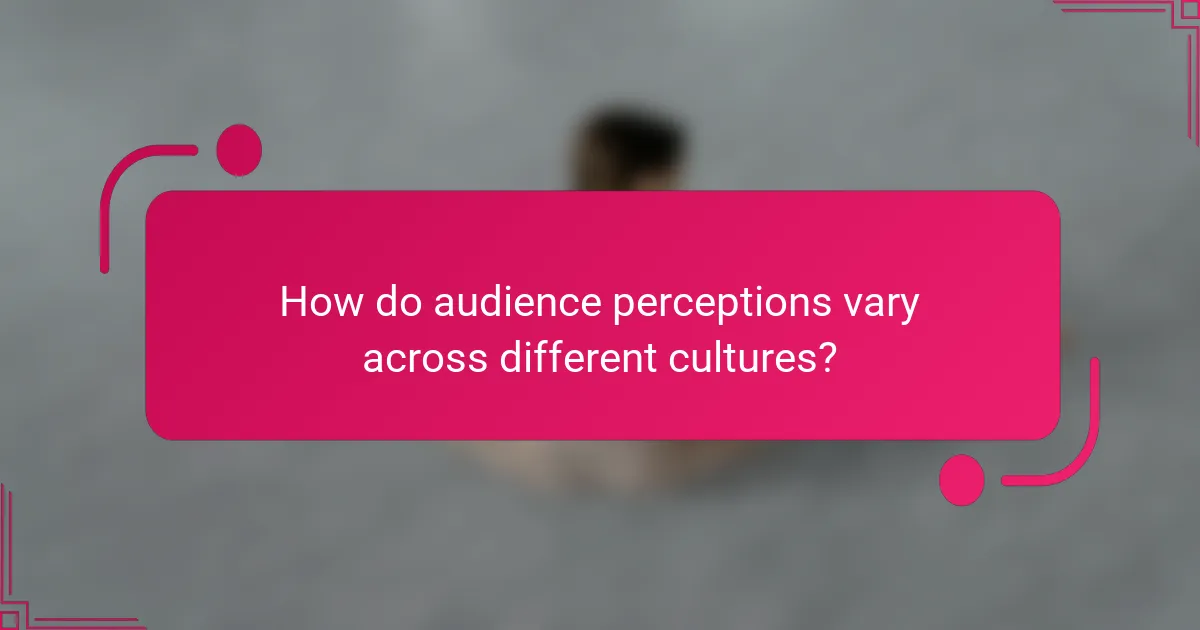
How do audience perceptions vary across different cultures?
Audience perceptions of contemporary sculpture innovations differ significantly across cultures due to varying artistic traditions and values. For example, Western cultures often emphasise individual expression and material experimentation, while Eastern cultures may prioritise harmony and symbolism. These cultural frameworks influence how audiences interpret materials, techniques, and movements in contemporary sculpture. Additionally, the incorporation of local materials and traditional techniques can create unique sculptures that resonate deeply with specific cultural narratives. Understanding these differences enhances appreciation for the diverse landscape of contemporary sculpture.
What factors influence public engagement with sculpture in urban spaces?
Public engagement with sculpture in urban spaces is influenced by accessibility, community involvement, and artistic relevance. Accessibility ensures that sculptures are located in high-traffic areas, making them visible and approachable. Community involvement fosters a sense of ownership, as local voices contribute to the selection and creation of art. Artistic relevance connects sculptures to contemporary issues or cultural narratives, enhancing their significance and resonance with the public. These factors collectively shape how people interact with and appreciate urban sculptures.
How do local traditions inform contemporary sculptural interpretations?
Local traditions significantly shape contemporary sculptural interpretations by influencing themes, materials, and techniques. Artists often draw inspiration from cultural narratives, integrating traditional motifs into modern forms. For instance, the use of local materials can reflect cultural heritage, while techniques passed down through generations may inform contemporary practices. This blending creates a dialogue between past and present, enriching the artistic landscape. As a result, sculptures not only serve aesthetic purposes but also embody cultural identity and continuity.
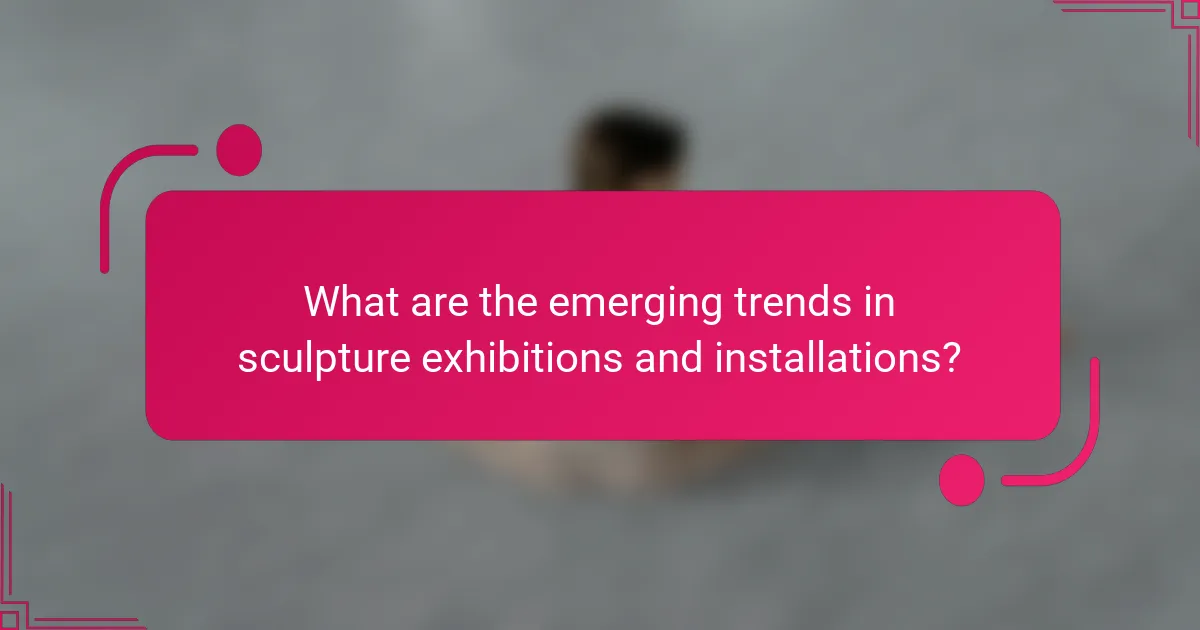
What are the emerging trends in sculpture exhibitions and installations?
Emerging trends in sculpture exhibitions focus on innovative materials, interactive techniques, and diverse artistic movements. Contemporary artists increasingly utilise sustainable materials, such as recycled plastics and biodegradable substances, to address environmental concerns.
Interactive installations invite audience participation, transforming passive viewing into an engaging experience. Artists are also exploring digital technologies, incorporating augmented reality and virtual elements to enhance their work.
Artistic movements emphasise inclusivity and cultural narratives, showcasing underrepresented voices. Collaborative projects and community-based installations foster dialogue about social issues, reflecting the evolving role of sculpture in contemporary society.
How are digital platforms changing the way sculptures are showcased?
Digital platforms are revolutionising how sculptures are showcased by enhancing visibility and accessibility. Artists can present their work to global audiences through virtual galleries and social media. Online platforms allow for interactive experiences, such as 3D modelling and augmented reality, enabling viewers to engage with sculptures in innovative ways. Additionally, these platforms facilitate direct sales and collaborations, transforming the traditional art market. The unique attribute of immediate audience feedback further influences artistic direction and trends in contemporary sculpture.
What role do interactive installations play in contemporary art experiences?
Interactive installations are crucial in contemporary art experiences as they engage audiences actively. These installations often incorporate innovative materials and techniques, allowing viewers to interact with the artwork, thus deepening their emotional and intellectual connections. This participatory approach reflects current artistic movements that prioritise viewer involvement over passive observation. Additionally, unique attributes of these installations, such as immersive technology and real-time feedback, create dynamic environments that challenge traditional notions of art. As a result, interactive installations not only enhance aesthetic appreciation but also foster a dialogue between the artwork and the audience.
What best practices can sculptors adopt for successful exhibitions?
Sculptors can enhance their exhibition success by prioritising audience engagement and effective presentation. Focus on innovative materials and techniques to create captivating pieces. Establish a strong narrative around the artwork, linking it to contemporary artistic movements. Utilise social media for promotion and community outreach to attract diverse visitors. Collaborate with other artists for cross-exposure and consider the exhibition layout to facilitate interaction.
